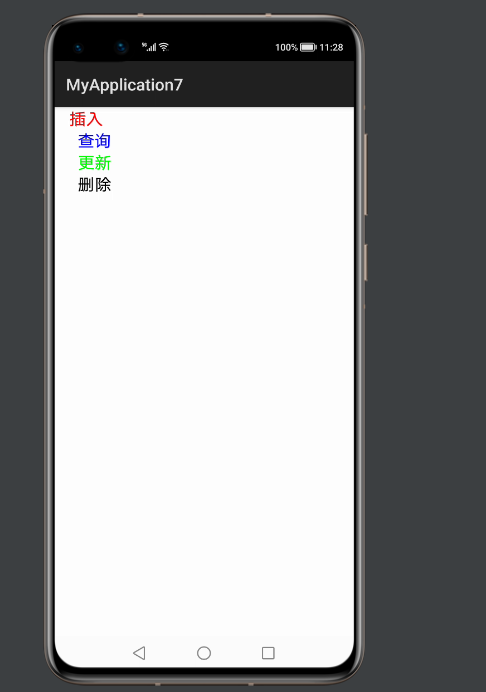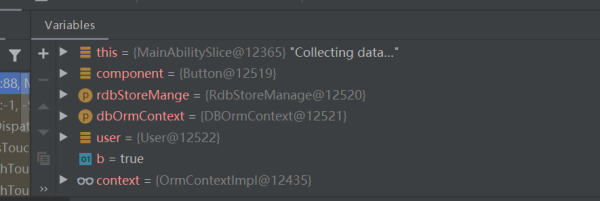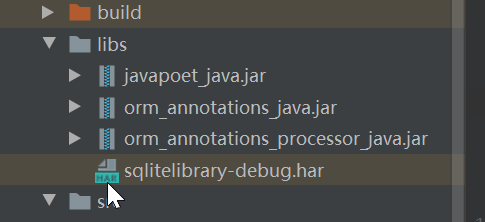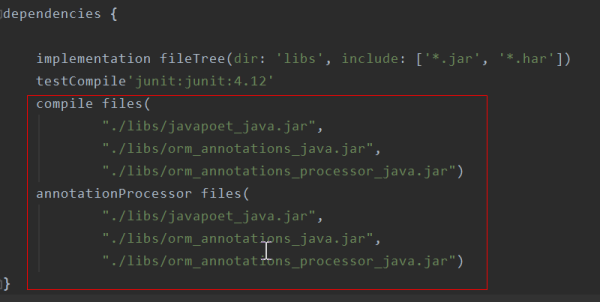- 1KubeSphere简介,功能介绍,优势,架构说明及应用场景_kubesphere是干嘛用的
- 2微信小程序即时聊天对话窗口静态源码_静态页面小程序源码
- 3Android Gradle 插件版本说明_buildfeatures.aidl
- 4Android studio使用MediaPlayer播放在线音频播放不了java.io.FileNotFoundException: No content provider_android 网络音频无法播放
- 5Android中处理崩溃异常_崩溃线程: #1 subthread
- 6曝鸿蒙系统向对手开放,华为鸿蒙系统的未来,向左还是向右?
- 74.MAC平台Python的下载、安装(含Python2.7+Python3.12双版本环境变量配置)——《跟老吕学Python编程》
- 8蓝桥杯十六进制与十进制的相互转换
- 9SIFT算法原理详解_sift账号
- 10关于启动eclipse报错 Could not create the Java Virtual Machine的解决办法_could not create the java virtual machine eclipse
鸿蒙harmonyos,鸿蒙HarmonyOS三方件开发指南(6)-ActiveOhos_sqlite组件
赞
踩

1. ActiveOhos功能介绍
1.1. 组件介绍
基于HarmonyOS据库进行sqlite数据库操作,创建连接时比较繁琐,本组件简化了sqlite数据库的连接,并且对HarmonyOS原生的API进行封装加强,使sqlite数据库的读写更加方便。
1.2. 手机模拟器上运行效果

插入数据成功

2. ActiveOhos使用方法
2.1. 为应用添加sqlitelibrary-debug.har包依赖
在应用模块中调用HAR,常用的添加依赖为:依赖本地HAR
第一步:将sqlitelibrary-debug.har复制到entry\libs目录下即可(由于build.gradle中已经依赖的libs目录下的*.har,因此不需要再做修改)。
查看工程目录中build.gradle下的*.har是否存在


第二步:除了依赖har之外还需要添加外部依赖用来实现类的引入,引入方式如下,引入完之后同步即可使用。
如果使用注解处理器的模块为“com.huawei.ohos.hap”,则需要在模块 “build.gradle”文件的“ohos”节点中添加以下配置:
compileOptions{
annotationEnabled true
}
如果使用注解处理器的模块为“com.huawei.ohos.library”,则需要在模块“build.gradle”文件的“dependencies”节点中配置注解处理器。查看“orm_annotations_java.jar”、“orm_annotations_processor_java.jar” 、“javapoet_java.jar” 3个jar包在HUAWEI SDK中的对应目录,并将这三个jar包导入项目中。
dependencies { compile files("orm_annotations_java.jar的路径
","orm_annotations_processor_java.jar的路径","javapoet_java.jar的路径")
annotationProcessor files("orm_annotations_java.jar的路径
","orm_annotations_processor_java.jar的路径","javapoet_java.jar的路径")}
如果使用注解处理器的模块为“java-library”,则需要在模块 “build.gradle”文件的“dependencies”节点中配置注解处理器,并导入“ohos.jar”。
dependencies { compile files("ohos.jar的路径","orm_annotations_java.jar的路径
","orm_annotations_processor_java.jar的路径","javapoet_java.jar的路径")
annotationProcessor files("orm_annotations_java.jar的路径
","orm_annotations_processor_java.jar的路径","javapoet_java.jar的路径")}
比如:


以上操作无误 之后就可以进行编码了!
3. ActiveOhos开发实现
3.1. 主页面的布局文件
定义四个按钮分别实现增删改查,定义四个Button实现请求点击事件
xmlns:ohos="http://schemas.huawei.com/res/ohos"
ohos:height="match_parent"
ohos:width="match_parent"
ohos:orientation="vertical">
ohos:id="$+id:btn_insert"
ohos:height="match_content"
ohos:width="80fp"
ohos:text_color="red"
ohos:text="插入"
ohos:text_size="20fp"
ohos:weight="100fp"/>
ohos:id="$+id:btn_query"
ohos:height="match_content"
ohos:width="100fp"
ohos:text_color="blue"
ohos:text="查询"
ohos:text_size="20fp"
ohos:weight="100fp"/>
ohos:id="$+id:btn_update"
ohos:height="match_content"
ohos:width="100fp"
ohos:text_color="green"
ohos:text="更新"
ohos:text_size="20fp"
ohos:weight="100fp"/>
ohos:id="$+id:btn_delete"
ohos:height="match_content"
ohos:width="100fp"
ohos:text_color="black"
ohos:text="删除"
ohos:text_size="20fp"
ohos:weight="100fp"/>
ohos:id="$+id:listText"
ohos:height="match_parent"
ohos:width="match_parent"/>
ohos:width="match_content"
ohos:background_element="$graphic:background_ability_main"
ohos:layout_alignment="horizontal_center"
ohos:text="get请求"
ohos:text_size="50"
ohos:top_margin="80vp"
/>
3.2. 例子代码如下
组件中有两种连接数据的方式,分别是OrmContext,RdbStore ,其中使用OrmContext连接方式时,需要定义一个实体类(User)来和数据库对应表名及字段,一个数据库类 BookStore 来配合开发,代码如下:
MainAbilitySlice
import com.example.myapplication.BookStore;
import com.example.myapplication.ResourceTable;
import com.example.myapplication.User;
import com.example.sqlitelibrary.DBManage;
import com.example.sqlitelibrary.DBOrmContext;
import com.example.sqlitelibrary.utils.Log;
import ohos.aafwk.ability.AbilitySlice;
import ohos.aafwk.content.Intent;
import ohos.agp.components.Button;
import ohos.agp.components.Component;
import ohos.data.DatabaseHelper;
import ohos.data.orm.OrmContext;
import ohos.data.orm.OrmPredicates;
import ohos.data.rdb.RdbStore;
import ohos.data.rdb.ValuesBucket;
import java.util.ArrayList;
import java.util.List;
publicclass MainAbilitySlice extends AbilitySlice implements Component.ClickedListener {
private DatabaseHelper helper;
private RdbStore store;
private OrmContext context;
@Override
publicvoid onStart(Intent intent) {
super.onStart(intent);
super.setUIContent(ResourceTable.Layout_ability_main);
helper = new DatabaseHelper(this);
DBManage dbManger = new DBManage("user.db","user");
context = dbManger.getConnectionContext(helper, BookStore.class);
// DBManage dbManger = new DBManage("user.db");
// store = dbManger.getConnectionStore(helper,"user");
Button btnInsert = (Button) findComponentById(ResourceTable.Id_btn_insert);
Button btnQuery = (Button) findComponentById(ResourceTable.Id_btn_query);
Button btnDelete = (Button) findComponentById(ResourceTable.Id_btn_delete);
Button btnUpdate = (Button) findComponentById(ResourceTable.Id_btn_update);
btnInsert.setClickedListener(this::onClick);
btnQuery.setClickedListener(this::onClick);
btnDelete.setClickedListener(this::onClick);
btnUpdate.setClickedListener(this::onClick);
}
@Override
publicvoid onActive() {
super.onActive();
}
@Override
publicvoid onForeground(Intent intent) {
super.onForeground(intent);
}
@Override
publicvoid onClick(Component component) {
// RdbStoreManage rdbStoreMange = new RdbStoreManage();
// ValuesBucket values= new ValuesBucket();
// values.putInteger("id", 1);
// values.putString("name","zhangsan");
// values.putInteger("age", 18);
// values.putDouble("salary", 100.5);
// values.putByteArray("blobType", new byte[] {1, 2, 3});
// rdbStoreMange.setSql(store, "insert into user values(zhangsan, 18, 100.5, byte[1,2,3])");
// long id = rdbStoreMange.insert(store,"user",values);
// System.out.println(id);
DBOrmContext dbOrmContext = new DBOrmContext();
switch (component.getId()) {
caseResourceTable.Id_btn_insert: //插入数据
//第一次使用user对应的表的时候,如果有这张表就直接使用,没有就创建表
Useruser= newUser();
user.setFirstName("Zhang");
user.setLastName("San");
user.setAge(29);
user.setBalance(100.51);
boolean b = dbOrmContext.insert(context,user);
Log.i("插入成功");
System.out.println(b);
break;
caseResourceTable.Id_btn_query: //条件查询
List users = new ArrayList<>();
OrmPredicates query = context.where(User.class).equalTo("lastName","San");
users = dbOrmContext.query(context, query);
break;
caseResourceTable.Id_btn_delete: //条件删除
OrmPredicates delete= context.where(User.class).equalTo("lastName","San");
intdelete1 = dbOrmContext.delete(context,delete);
System.out.println(delete1);
break;
caseResourceTable.Id_btn_update: //条件更新
ValuesBucket valuesBucket = new ValuesBucket();
valuesBucket.putInteger("age", 31);
valuesBucket.putString("firstName","Zhang");
valuesBucket.putString("lastName","San");
valuesBucket.putDouble("balance", 300.51);
OrmPredicates update= context.where(User.class).equalTo("userId", 1);
intupdate1 = dbOrmContext.update(context, valuesBucket,update);
System.out.println(update1);
break;
}
dbOrmContext.flush(context);
}
}
user.java
@Entity(tableName ="user", ignoredColumns = {"ignoreColumn1","ignoreColumn2"},
indices = {@Index(value = {"firstName","lastName"},name="name_index",unique=true)})
publicclassUserextends OrmObject {
// 此处将userId设为了自增的主键。注意只有在数据类型为包装类型时,自增主键才能生效。
@PrimaryKey(autoGenerate = true)
private IntegeruserId;
private String firstName;
private String lastName;
private intage;
private doublebalance;
private intignoreColumn1;
private intignoreColumn2;
// 开发者自行添加字段的getter和setter 方法
BookStore.java
@Database(entities = {User.class}, version = 1)
publicabstract class BookStore extends OrmDatabase {
}
项目源代码地址:https://github.com/isoftstone-dev/Active_HarmonyOS
欢迎交流:HWIS-HOS@isoftstone.com
©著作权归作者和HarmonyOS技术社区共同所有,如需转载,请注明出处,否则将追究法律责任
【编辑推荐】


